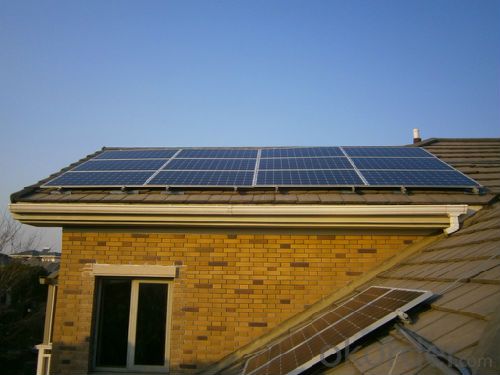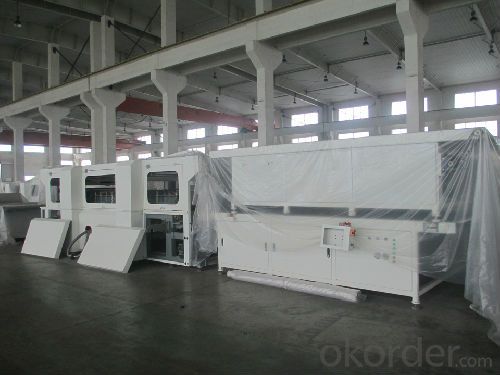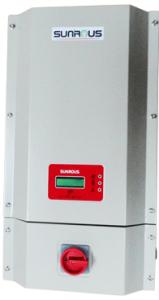PV Grid-Tied Inverter Dual MPPT-US Solar Inverter
- Loading Port:
- Shanghai
- Payment Terms:
- TT or LC
- Min Order Qty:
- 10 mm
- Supply Capability:
- 1000 mm/month
OKorder Service Pledge
OKorder Financial Service
You Might Also Like
PV Grid-Tied Inverter Dual MPPT-US Solar Inverter
GT3.6-ZX-01/HF | |
Input(DC) | |
Max.DC Power | 3600W |
Max.DC Voltage | 500V |
PV Voltage range, MPPT | 60V ~ 360V |
Max.input current | 30.0A |
Number of MPP trackers | 2 |
Max.number of strings (parallel) | 4 |
Output(AC) | |
Nominal AC power / | 3600W/3600W |
Max.output current | 16.0A |
Nominal AC Voltage / range | 180V~264V |
AC grid frequency / range | 47.5-51.5Hz / 59.3-60.5Hz |
Power factor at rated power | 1 |
THD | < 3% |
AC connection | Single-phase |
Efficiency | |
Max. efficiency/Californian efficiency | > 98.0% / > 97.0% |
MPP adaptation efficiency | > 99.0% |
Protection devices | |
DC reverse polarity protection | √ |
AC short-circuit protection | √ |
Ground fault monitoring | √ |
Grid monitoring | √ |
Output Transient Voltage Suppression | √ |
Over load | √ |
Anti-islanding | √ |
General data | |
Dimensions (W/ H / D) in mm | 370 / 540 / 185 mm |
Weight | 23kg |
Operating temperature range | -25 ~ +60℃ |
Storage temperature range | -40 ~ +70℃ |
Ambient humidity | 0 ~ 100% |
Consumption (night) | < 0.5W |
Topology | HF-transformer galvanic isolation |
Cooling concept | Convection |
Enclosure type | IP65 / NEMA 3R |
Features | |
DC connection: PV special connector | √ |
AC connection: connector | √ |
LCD display & Backlit | √ |
LED display | √ |
Interfaces: RS485 | √ |
Warranty: 10 years | √ |
Certificates & approvals | G83 / G59 / TUV / SAA / ETL / JET/ CE |


- Q:How does a solar inverter handle voltage and frequency variations caused by grid disturbances?
- A solar inverter is designed to handle voltage and frequency variations caused by grid disturbances by employing various control mechanisms and protection features. Firstly, the inverter continuously monitors the voltage and frequency levels of the grid, and it adjusts its output accordingly to match the grid's requirements. If there is a voltage or frequency fluctuation, the inverter will either increase or decrease the output power to maintain the desired voltage and frequency levels. To handle voltage variations, the solar inverter utilizes a voltage regulation mechanism. If the grid voltage increases or decreases beyond a certain threshold, the inverter adjusts its internal voltage regulation circuitry to ensure a stable and regulated output voltage. This helps protect the inverter and connected devices from potential damage due to overvoltage or undervoltage conditions. Similarly, to handle frequency variations, the solar inverter incorporates a frequency control mechanism. If the grid frequency deviates from the specified range, the inverter adjusts its internal frequency control circuitry to maintain a stable and accurate output frequency. This ensures that the power generated by the solar panels remains synchronized with the grid, allowing for efficient power transfer and preventing any damage to the inverter or connected devices. Furthermore, solar inverters often include advanced features such as anti-islanding protection. This feature detects any abnormal grid conditions, such as voltage or frequency fluctuations beyond a safe limit. If an islanding condition is detected, where the solar system continues to generate power even when the grid is down, the inverter will disconnect from the grid to prevent any potential safety hazards for utility workers. Overall, a solar inverter is designed to handle voltage and frequency variations caused by grid disturbances through continuous monitoring, voltage regulation, frequency control, and protective features. These capabilities ensure reliable and safe operation of the solar power system while maintaining a stable connection with the utility grid.
- Q:How does a grid-tied solar inverter work?
- A grid-tied solar inverter works by converting the direct current (DC) electricity produced by solar panels into alternating current (AC) electricity that can be used to power homes or businesses. It synchronizes the AC electricity it generates with the electrical grid, allowing excess electricity to be sent back to the grid for credits or future use. This inverter also monitors the grid's voltage and frequency to ensure the solar system operates safely and efficiently.
- Q:Can a solar inverter be used with a solar-powered water pump?
- Yes, a solar inverter can be used with a solar-powered water pump. The solar inverter is responsible for converting the direct current (DC) power generated by the solar panels into alternating current (AC) power that can be used to operate the water pump. This allows for a more efficient and reliable operation of the solar-powered water pump system.
- Q:Can a solar inverter be used in mobile applications?
- Yes, a solar inverter can be used in mobile applications. Mobile solar inverters are specifically designed to convert the direct current (DC) power generated by solar panels into alternating current (AC) power that can be used to charge mobile devices or power small appliances while on the go. These inverters are typically compact, lightweight, and have features like USB ports or built-in batteries to provide convenient and portable power solutions.
- Q:How do you calculate the payback period for a solar inverter?
- To calculate the payback period for a solar inverter, you need to determine the initial cost of the inverter and then calculate the annual savings or earnings generated by the inverter. Divide the initial cost by the annual savings to get the payback period, which is the time it takes to recoup the investment through savings or earnings.
- Q:How does the weight of a solar inverter affect its installation process?
- The weight of a solar inverter can significantly impact its installation process. Heavier inverters may require additional support structures or mounting equipment to ensure proper installation and stability. They may also require more manpower and specialized equipment during the installation process. Conversely, lighter inverters may be easier to handle and install, potentially reducing installation time and effort. Therefore, the weight of a solar inverter is an important consideration that can influence the overall installation process.
- Q:Can a solar inverter be used with electric vehicles?
- Yes, a solar inverter can be used with electric vehicles. It allows for the conversion of DC power generated by solar panels into AC power that can be used to charge the electric vehicle's battery. This helps to make the charging process more efficient and environmentally friendly by utilizing renewable energy sources.
- Q:Can a solar inverter be used with a monitoring system?
- Yes, a solar inverter can be used with a monitoring system. In fact, many solar inverters come with built-in monitoring capabilities, allowing users to track and analyze the performance of their solar energy system in real-time. Additionally, there are also external monitoring systems available that can be connected to the solar inverter to provide more detailed data and insights on energy production, consumption, and system efficiency.
- Q:How does a solar inverter handle variations in solar panel degradation over time?
- A solar inverter handles variations in solar panel degradation over time by continuously monitoring the power output of the solar panels and adjusting its operations accordingly. As solar panels degrade over time, their efficiency decreases, resulting in a decrease in power output. The inverter detects this decrease and adapts its operation to maximize the power conversion and maintain optimal performance. This ensures that the solar energy harvested from the panels is efficiently converted and utilized, despite variations in panel degradation.
- Q:What are the safety considerations when installing a solar inverter?
- Some safety considerations when installing a solar inverter include ensuring proper grounding and electrical connections, following manufacturer's guidelines and instructions, and having a licensed electrician perform the installation. It is also important to be cautious of potential electrical hazards and to handle the inverter with care to avoid any personal injuries.
1. Manufacturer Overview |
|
|---|---|
| Location | |
| Year Established | |
| Annual Output Value | |
| Main Markets | |
| Company Certifications | |
2. Manufacturer Certificates |
|
|---|---|
| a) Certification Name | |
| Range | |
| Reference | |
| Validity Period | |
3. Manufacturer Capability |
|
|---|---|
| a)Trade Capacity | |
| Nearest Port | |
| Export Percentage | |
| No.of Employees in Trade Department | |
| Language Spoken: | |
| b)Factory Information | |
| Factory Size: | |
| No. of Production Lines | |
| Contract Manufacturing | |
| Product Price Range | |
Send your message to us
PV Grid-Tied Inverter Dual MPPT-US Solar Inverter
- Loading Port:
- Shanghai
- Payment Terms:
- TT or LC
- Min Order Qty:
- 10 mm
- Supply Capability:
- 1000 mm/month
OKorder Service Pledge
OKorder Financial Service
Similar products
New products
Hot products
Hot Searches
Related keywords
































